International cruise is a two-month adventure for couple
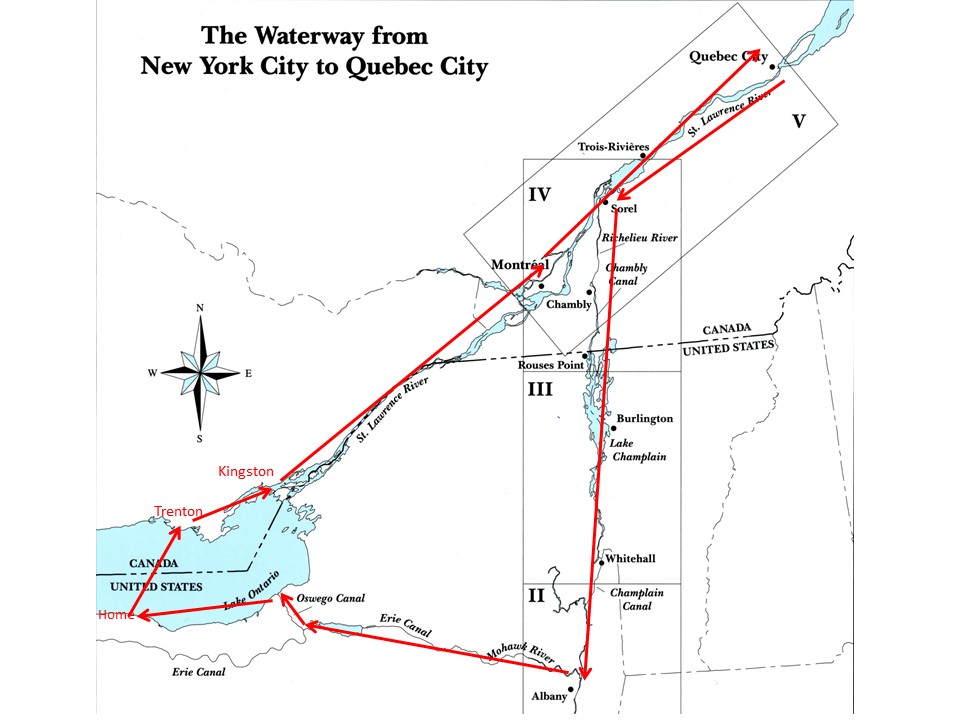
Introduction by Founders Award Committee Chair Beth Mansfield
The Founders Award is an annual GLCC member award for the best log of a Great Lakes cruise. This award is named in honor of the Club’s 1934 eight founding members and is an opportunity for awardees to share experiences and knowledge with today’s GLCC members. The award recognizes members for exemplary skill and artistry in recording their cruises on the Great Lakes.
This year’s award recipients, Mary and Wes Micket, won the award for their “Triangle Loop” cruise in the summer of 2019. They share their adventure here. As many of our members
cruise extensively each summer, we hope the Mickets’ log spurs interest in extended cruising by GLCC members and encourages them pursue this recognition.
Cruise Log submission:
Mary Micket: My husband, Wes, and I spent the summer of 2019 on the cruise of a lifetime. We took 69 days to make a voyage that covered 1,145 miles, 53 locks and included three major cities (Montreal, Quebec City, and Burlington, Vt.). During the journey we sent updates to friends via email. I have consolidated and condensed those emails into this story of our adventure.
June 13, 2019: The adventure begins
We traveled on our 45-foot Sea Ray cruiser, Egeszsegedre II, which is Hungarian for Cheers. In this log it will be known as Eggy, which is what we call her on the marine radio. (By the way, neither of us is Hungarian. It’s a long story … .)
We started our adventure by heading from our home port of Irondequoit Bay (near Rochester, NY) to Trenton, Ont. By visiting Trenton, we could attend the Great Lakes Cruising Club Lake Ontario Rally. We have made good friends through the club. This was a chance to catch up with them and meet some other folks who are now friends.
After a smooth cruise across Lake Ontario, we headed through the picturesque Murray Canal. The canal has two swing bridges. The fee of $5 (Canadian) was collected by the bridge tender holding out a basket on a long pole. I put the money (and a bag of Fritos) in the basket from the bow of the boat and received a big thumbs up.
Trenton has one of the newest and best marinas on Lake Ontario, the Trent Port Marina (www.quintewest.ca/en/marina/Trent-Port-Marina.asp). It is within easy walking distance of a large grocery store and several good restaurants. There are excellent facilities at the marina, including free laundry services. Gas/diesel and pump-outs are available less than a mile away at a facility run by the marina staff. The Canadian Air Force Museum with its many interesting exhibits is a short cab ride from the marina.
We were greeted upon arrival by GLCC Rear Commodore Eric Sunstrum and Cindy Sunstrum, Port Captain of the Thousand Islands. They arrived on S/V Northern Whisper earlier in the day.
One of the purposes of the rally is to share information and experiences. This year, one of the sessions was presented by Don Knap, a GLCC member who is a retired firefighter. We experimented with several types of extinguishers and got practical safety tips for our boats.
Of course we had to have socializing time. We had two nice dinners at local restaurants, a barbecue and ’60s themed dance at the marina.
June 17 -21, 2019: Kingston, Ont.
On Monday we traveled from Trenton to Kingston, Ont., via the Bay of Quinte. The bay is a great way to avoid the open waters of Lake Ontario. We planned to leave Kingston Thursday morning, but the forecast was for rain (and boy did it rain) so we “forced” ourselves to stay another day.
Kingston is one of our favorite ports on Lake Ontario. We enjoy the city because Confederation Basin is in the heart of an active downtown. (https://www.cityofkingston.ca/residents/recreation/facilities/marinas/c…). The area around the marina includes stores, restaurants and a park which frequently hosts music and other events.
The City Hall, built in 1844, is lit in different colors each night providing a beautiful view from the marina.
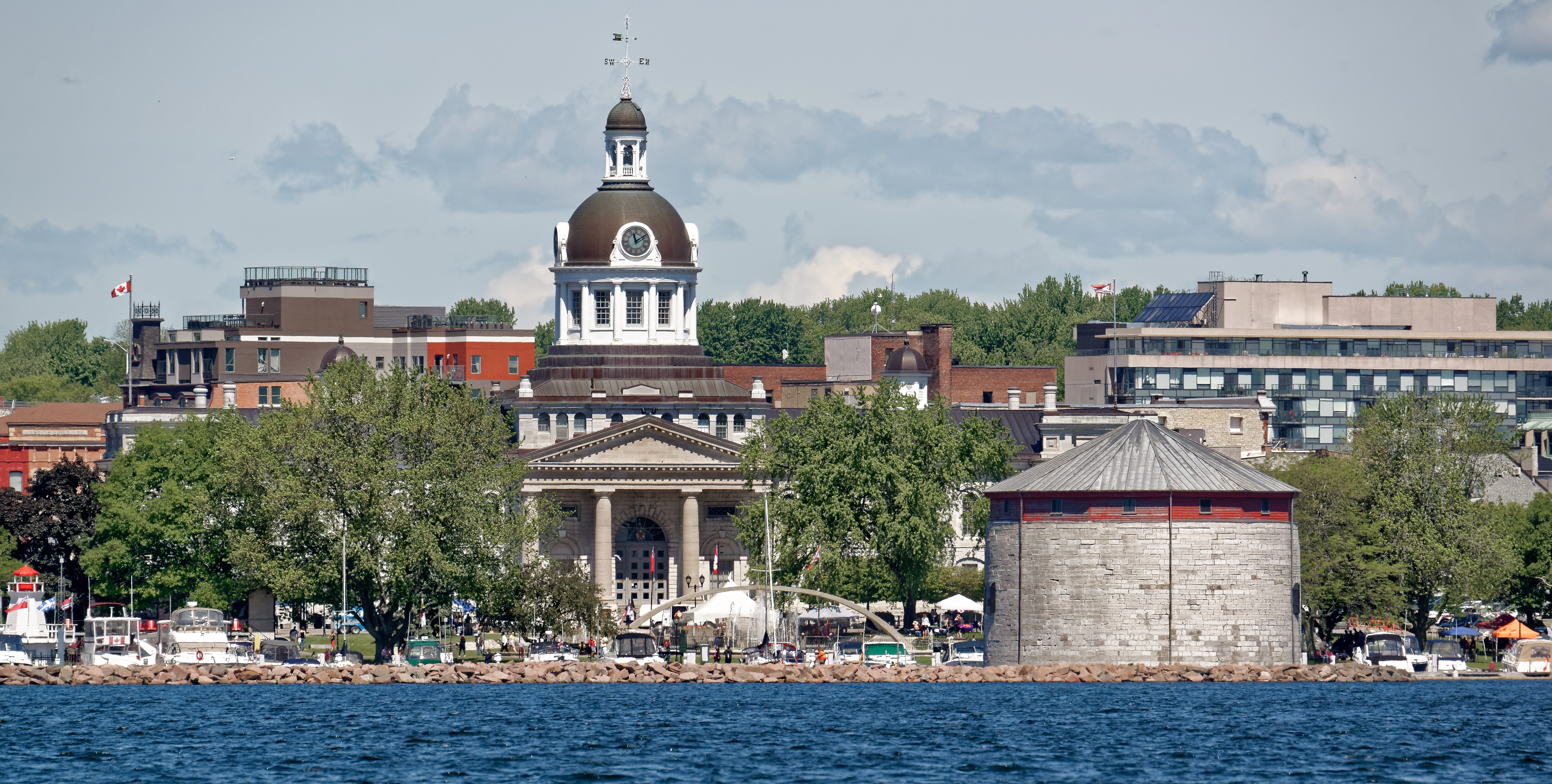
Kingston from the marina
While in Kingston, we stocked the boat with food, beer, and wine. We enjoyed several nice dinners; there are many fun restaurants near the marina. Two of our favorites are Chez Piggy and Tango Nuevo. We also enjoyed visits from Eric and Cindy Sunstrum and George Dew and Hélène Carriere as they traveled to their home ports from the rally.
June 22-23, 2019: Brockville, Ont.
We arrived in Brockville on Friday after a beautiful cruise through the Canadian portion of the Thousand Islands on the St. Lawrence River.
A section of the river is the Gananoque Narrows. It never seems to fail that when we are going through it, so is a tour boat. This year was no exception. The wake produced by that boat makes for an interesting ride.
The Brockville town harbor (https://brockville.com/municipalharbour) is on the river and is a great place to watch freighters coming through the St. Lawrence Seaway. The harbor has an original Canadian CF86 fighter plane mounted in the park.

A freighter and a fighter
For years, there has been a gated entrance to an old railway tunnel (built in 1853) near the marina. Over the past two years, the town invested in the safety improvements required to open the tunnel to foot traffic.
The walls and ceiling are original, but there is a new concrete floor so you can walk the third-of-a-mile tunnel. They have put in LED lights and a sound system. As you are walking through, it may sound like a train is coming. A few minutes later, the lights are matching Bryan Adams’ song, The Summer of 69 (released in 1985).
It was a great walk. The original masonry was beautiful. The popular tunnel is free and open every day.
June 23-26, 2019: Brockville to Valleyfield
We left Brockville on Sunday morning to travel through the first of seven Seaway locks. These are big, commercial locks. As recreational boaters, we get low priority. In 2016, we traveled east to west, going up in each lock. This trip, three years later, we will be going west to east, with the current, and headed down in each lock.
A must-read document for information on traveling in the Seaway locks is at https://greatlakes-seaway.com/en/the-seaway/our-locks-and-channels/#.
We cruised past the town of Prescott where we have docked many times over the years. The good news for the town is that the municipal marina has lots of seasonal boaters now. Unfortunately, that leaves less room for transients like us.
We went past Fort Wellington and the very first starch factory in North America built in 1858 (it still makes multiple products, including fructose corn syrup).
Shortly after Prescott, we had one of our easiest lockages ever, at the Iroquois Lock. When we approached the lock, the lights were green so we could go directly in, something that rarely happens on the Seaway Locks.
The main function of the Iroquois Lock is to adjust the traffic transiting the St. Lawrence Seaway to the water level of Lake Ontario. This means that the drop or lift typically is between 2 to 6 feet.
However, in 2019, since the water in both the lake and the river were so high. we were only dropped about 6 inches. We were in and out of the lock in less than 10 minutes.
We cruised to the Chrysler Park Marina (http://www.cryslerparkmarina.com/). The marina is close to the Upper Canadian Village. It is a popular spot, but we spent a quiet evening on board.
There is a website from which we can monitor the estimated times that freighters will be going through the locks. Since they have priority for locking through, knowing where they are can save lots of waiting time. (https://www.seaway.dot.gov/explore/interactive-shipping-map-and-shippin…)
On Monday, we traveled to Valleyfield, in the province of Quebec, transiting through the Eisenhower and Snell locks. No freighters were scheduled for the locks between 9 and noon, so, we left our dock at 8:30 and arrived at Eisenhower at 9:30. The lights turned green as we approached so once again we drove directly in.
These locks each dropped us about 45 feet. We connected to the wall by dropping our midship line over a bollard that floats down the wall as the water drops. My job is to lasso the bollard with the line as Wes brings the boat up toward it. It sounds easy, but I always fret that I will not catch it. But I was successful both times.
Once tied to the bollard, we monitor the bow and stern with boat hooks as the water flows out of the lock quickly. It is much smoother than going up with the water rushing in.
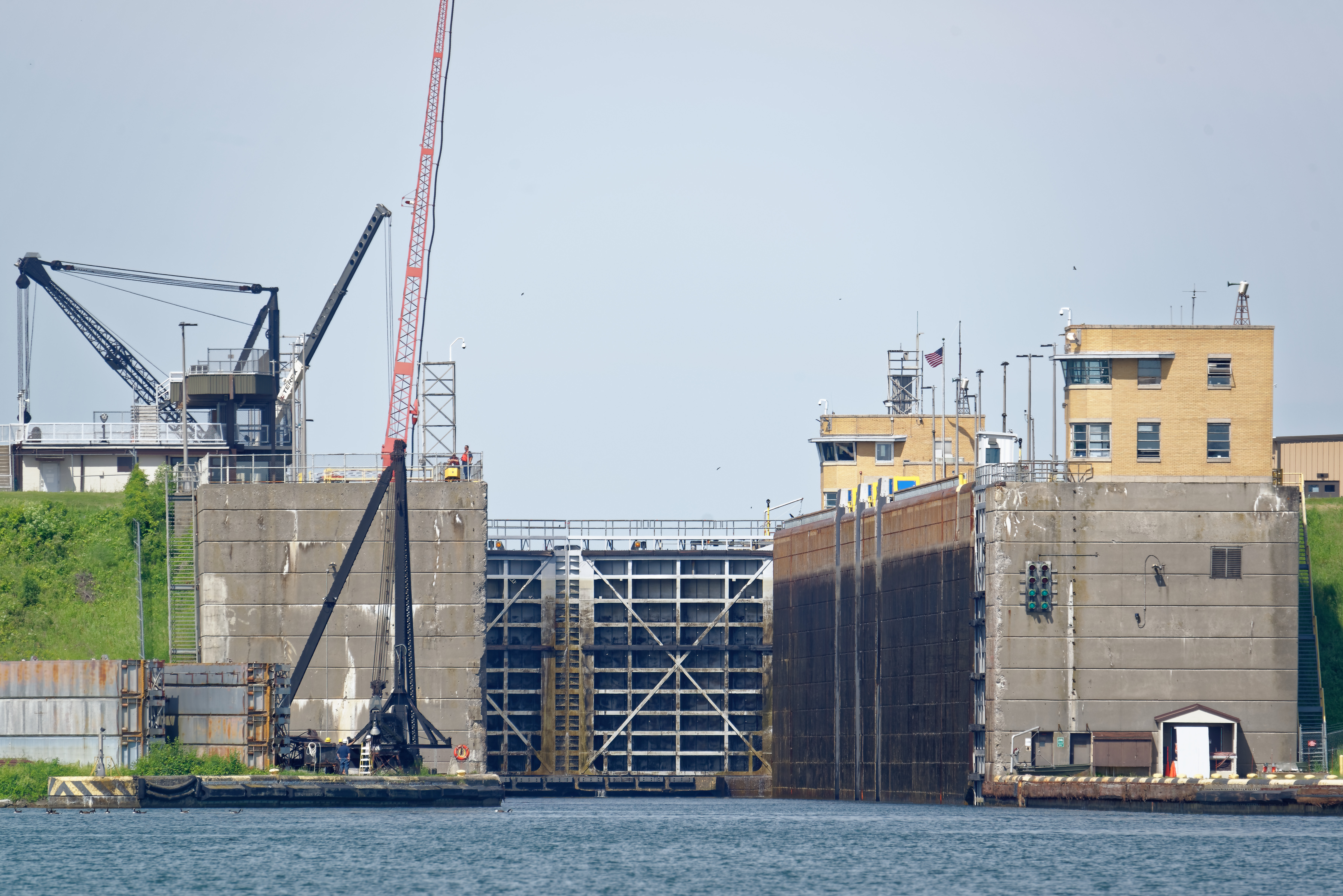
Exiting Eisenhower Lock
After the locks, we traveled through a section of the river that is so wide it is considered a lake. Since it was Saint-Jean Baptiste Day, a Quebec provincial holiday, Lake St. Francis was busy with recreational boaters. The marina we stayed at had a busy fuel dock but after a short wait we filled up and were tied up at our dock.
The marina has a nice ship’s store and very helpful staff many of whom speak English. (http://marinavalleyfield.com/). The town is within a short walk through a park. There were several nice restaurants and a grocery store.
Tuesday morning was rainy, so it was a good time for cleaning and organizing the inside of the boat. By afternoon the rain stopped so we could reward ourselves with a nice dinner on the back of the boat.
June 26-27, 2019: Lachine
On Wednesday we left Valleyfield and traveled to Lachine, a suburb of Montreal. While the trip would be about an hour by car, our trip was closer to five hours, and we had almost no delays.
There are two major highway bridges that must be lifted for boats over 12 feet to pass under, and they operate at set times. The first bridge lifts at 9, 11 and 2. The second opens an hour later. So you need to watch your time carefully. We arrived perfectly at 8:55 and the bridge went up promptly at 9. We then had one hour before the next bridge would open and it was less than five miles away, so we went very slowly and arrived just before 10. However, for reasons that were not explained, they did not raise the bridge until 10:15, so we circled a bit.
The next part of the adventure was the Beauharnais locks. These locks each lowered us about 42 feet. The locks are about a mile apart in a narrow area. We met a large freighter as it came out of the lock. There was not much room to avoid his wake, some of which ended up over our bow.
Based on our handy new tool to monitor the time for commercial ships, we knew there should be no more freighters for a while so thought we might get to lock right through. However, we had to wait for about 45 minutes while they lowered the lock and brought up another recreational boater. The second lock was waiting for us, and we were on our way into Lake St. Louis.
We spent two nice nights in Lachine and then headed out to Montreal on Friday morning. We stayed at the Port-de-Plaisance Marina which has since closed.
June 28-July 6, 2019: Montreal
On Friday, June 28, we traveled from Lachine to Montreal. Again, it was a much longer trip by boat than car, but much more fun. The main area of the river is called the Lachine Rapids and has many rocks and little falls. The Canal de Sud, which we traveled through, was built to allow cargo ships (and now recreational boaters) to travel between Montreal and Lake Ontario. There are two locks in the canal, a part of the Seaway system.
Even though each lock is long enough for freighters, they have recreational boaters raft off each other so there are fewer lines for the tenders to monitor. Rafting together is a great way to meet fellow boaters and share stories.

Lock buddies
We have to cruise by the Montreal harbor because of the island in the river. Up until this point, we have been traveling with the current. Once we pass the island and turn back toward Montreal, the current is pushing against us. And all the water from Lake Ontario (that picked up speed when it came over the Lachine rapids) is coming at us.
There have been several warnings this year about boats not being powerful enough to fight the current and get into Montreal harbor. Our lock buddies decided not to try the run into Montreal and stayed on the other side of the river.
Wes had to really power up Eggy. The current reduced our speed about 8 mph. It also made for a pretty rough ride. But we made it. The view and time in Montreal was worth the effort.
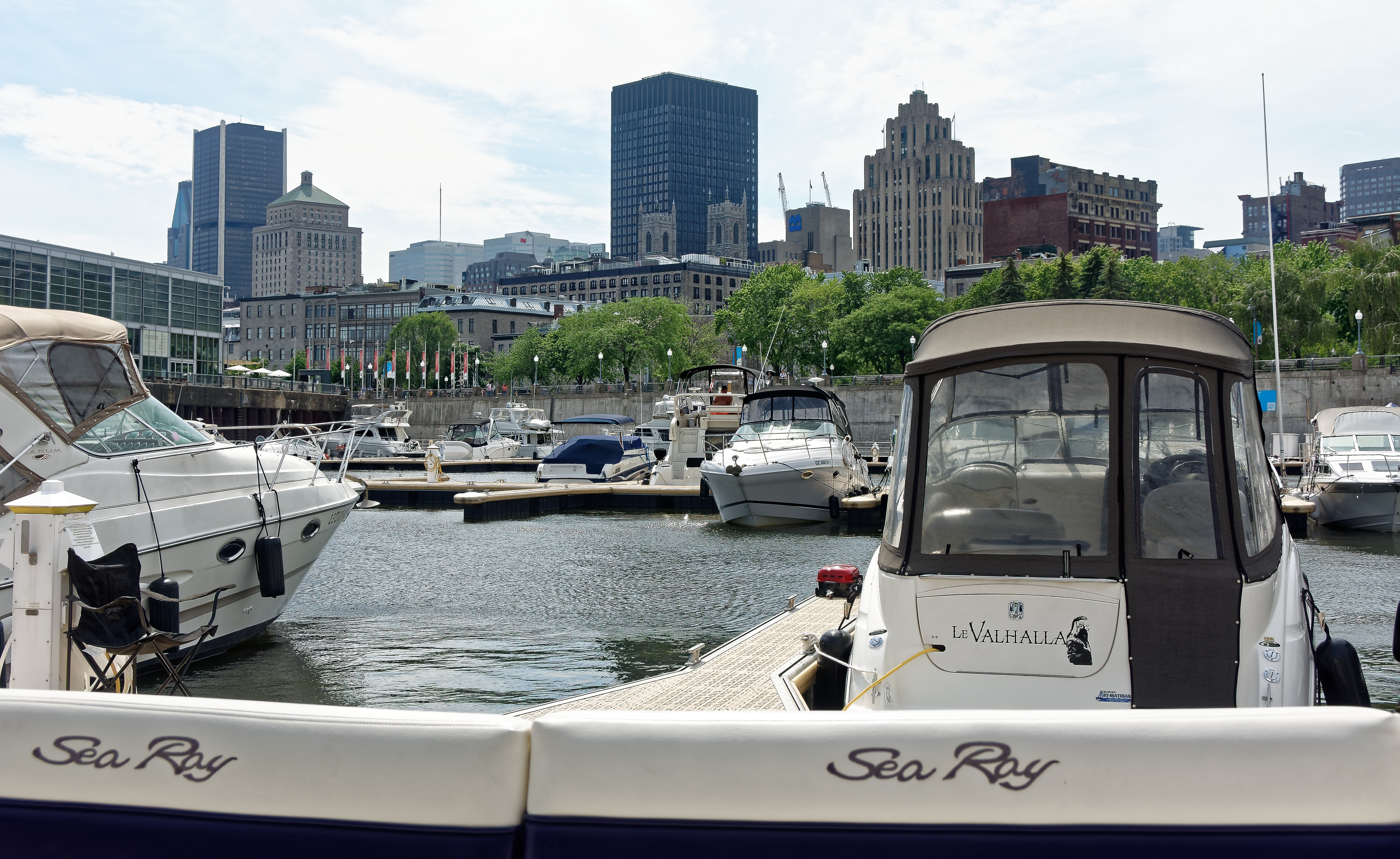
Montreal
There are two nice places to dock within walking distance of Old Town Montreal: The Yacht Club Montreal (www.ycmi.com) and Port d’escale Marina of the Old Port of Montreal. (www.bonjourquebec.com/en-us/listing/tourist-organizations-andtransporta…)
We stayed at Old Port in the center of the tourist area. It has nice facilities and excellent security. There is easy-to-use public transportation from both marinas to get any place in the city.
We had planned to stay five nights, and ended up being there for eight. We had to wait two days to receive an updated chip for our navigation system and then heavy rain was predicted so we opted to stay another night.
Some fun things we did in Montreal
• On Canada Day, we walked to the nearby park where at noon the Canadian Army fired a 21-gun salute to start the celebrations. We enjoyed several fireworks displays.
• We went to the Museum of Archeology, built on the site of the first European settlement in Montreal in approximately 1634. It is an actual archeological site and they have dug through the various layers of history and enclosed them in glass so you can see what it looked like from the 1600s to the1850s.
• In the evenings, we walked to various locations where you can view a story of the area projected onto a building and listen to the narration on your phone.
• The Montreal Jazz show was a short cab ride away. It was very hot, so we did not wander the outdoor shows except on our way to see Alan Parsons at a beautiful, and air conditioned, theater.
• We took a ferry to the park across the river that contained an arsenal built by the English after the War of 1812. The arsenal has been converted to a museum, showcasing the early history of Montreal. There is also a popular amusement park on the island which we did not visit.
July 7, 2019: Montreal to Trois Rivieres
On Sunday, July 7, we finally tore ourselves away from Montreal. We were ready to leave the big, exciting city behind. We had an end dock that provided a great view. However, several tourist boats were operating nearby and between that and the high water and concrete walls, it was very bouncy. That made sleeping, cooking and doing other boat chores interesting.
As we left Montreal, we drove past the Port of Montreal which goes on for miles. It is a working port where many freighters load and offload goods from around the world. These carriers serve more than 110 ports in each of the six Great Lakes states and two provinces (Ontario and Quebec). Over the past two years, cargo volume has risen by 17% to 41 million tons. That is a LOT of stuff. Hundreds of ships from over 50 countries make 3,000 to 4,000 transits through the Seaway each year between March and December.
Port of Montreal, 2019
During the some 60-mile trip to Trois-Reveres, we passed at least five of these large freighters. It was fun but we had to be careful not to get caught in their wakes. We could not figure out what one freighter was doing because it came very close to hitting a channel marker. But just as he got near it, he dropped his anchor. It was apparently ahead of schedule for its arrival in its next port.
We docked at the Trois-Reveres marina (https://www.marinatroisrivieres.com/) and had a nice on-board dinner.
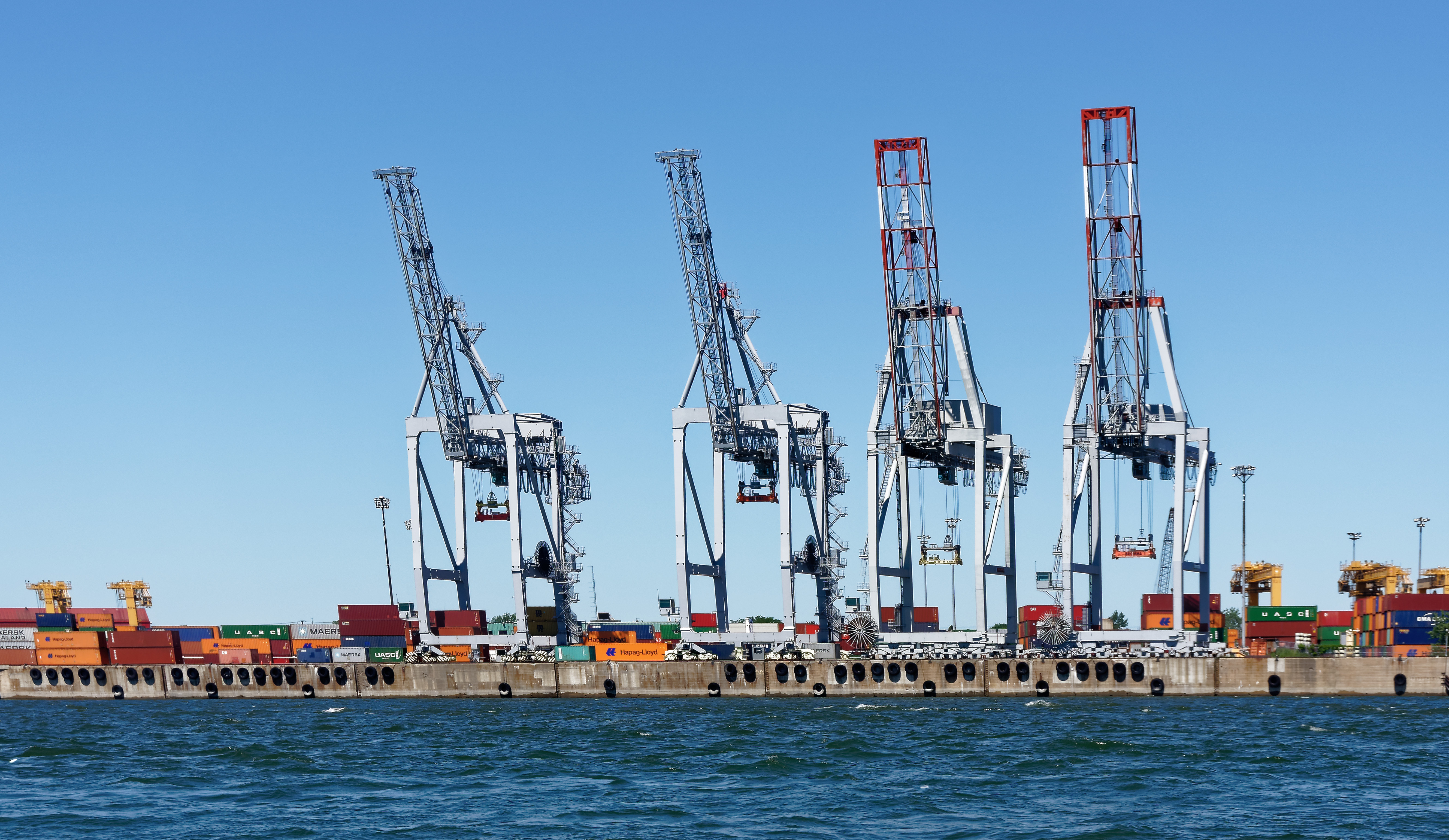
July 8-15, 2019: Quebec City
The tides from the Atlantic Ocean come into the St. Lawrence and reach inland as far as Trois-Rivieres. If you leave when the tide is coming in, you get caught in the fight between the incoming tides and the outgoing current of the St. Lawrence. If you time it right, you can ride the combination of the tides. That is much more comfortable, fuel-efficient and speedy.
Thanks to Wes’s careful reading of the recommendations and the tide tables, we had a nice trip. We hit a speed record for Eggy of 32 mph. Normally at 2600 rpms we would be making ~26 mph best-case.
The tides change the level of the St. Lawrence in the Quebec area by an average of 13 feet twice a day. To protect the marina from these wide swings, there is a lock between the river and the marina. The lock has floating docks you tie to and it raises or lowers you whatever is required to get you to the water level in the marina. The lock runs from 7 a.m. until 9 p.m., so if you are docked here there are no late-night excursions on the river. https://www.portquebec.ca/activites-et-loisirs/marina-du-port-de-
quebec/informations-generales
The city was founded in the mid-1600s and is full of history and tourists. We visited by car for our 20th anniversary (23 years ago!) and I always remembered the beautiful buildings on the hill. I managed to get a picture of them from the waterfront just before we entered the lock.

Coming into Quebec City, 2019
The old town has two levels and many, many steps, but is a fun area to walk through. They have a funicular that runs between the levels when you are too worn out (or it is too rainy) for the walk. It provides a beautiful view of the harbor.
During our visit to Quebec City we had several great adventures, including:
• A trip to the “Grand Market.” The websites we used for planning the trip referenced a great market close to the marina. However, it has moved into the suburbs. We decided to Uber there and were glad we did. There were fish, meat, cheese, fresh pasta, produce and bakery shops all under one roof, along with a wine shop. We spent several hours wandering and purchasing fun things to have on the next leg of the trip. Our only regret was the limited refrigerator and freezer space. But we packed a lot of goodies into that space.
• We remembered enjoying a glass of wine on the terrace of the Le Château Frontenac when we visited by car years ago. However, there was no terrace restaurant anymore. Fortunately, they have a new indoor spot with a view of the river and an excellent cheeseboard for lunch.
• The terrace has been closed because in the early 2000s someone realized that underneath that area had been the basement of the first governor’s home, the Chateau St. Louis. Canada Parks took over the area and has done a lot of archaeological work. The underground site is now open to tours, which we took. They have recovered items from the late 1600s to the 1800s.
• The Lady of Victories Church is in the middle of Old Town. It was built by the French to celebrate their victory over an attempted British naval invasion in the late 1600s. The British never really attacked because the French convinced the British that there were better fortifications and a lot more people in the settlement than were actually there. It was renamed Our Lady of Victories in 1711 when the British were again “defeated.” This time they could not land because of storms.
We spent seven lovely days in Quebec and could have found things to fill several more days. We were into the second month of our journey and still having a great time.
July 15 to July 18, 2019: Quebec to Sorel
As expected, our trip from Quebec City back to Trois-Rivières was slower than our journey in the other direction. For part of the ride, we were only making 18 mph compared to 32 mph on the trip to Quebec City. While slow (due to the current coming at us and no help from tides) it was relatively smooth because Wes had timed it so we were not also fighting the tides.
After spending the night at Trois-Rivières, we made a three-hour hop to Sorel which is the third-oldest town in Canada. It is very much a port and industrial city. We stayed in a marina on the outskirts of town and did not leave the marina area. There was a nice restaurant on the site which had a great view of the river. We visited one afternoon for poutine and another for dinner. (https://www.marinasaurel.com/)
We used the rainy days to plan out the rest of the trip, do laundry, clean the boat, do some maintenance, and sleep in a bit. We have been so busy enjoying each town that we needed those days to rest and get Eggy ready for the remainder of the trip.
July 18-20, 2019: The Richelieu River
On Thursday, July 18, we departed Sorel and headed south on the Richelieu River. The Richelieu flows north into the St. Lawrence so while we are headed south, it is considered going upstream.
After about 12 miles on the river, the St. Ours Lock raised us 5 feet. It was one of the nice, easy locks where we just tied off to the dock and the dock raised with us. No need to fend the boat off a wall.
There are many small pretty towns on both sides of the river. There are a number of cable ferries connecting the towns. We are used to cable ferries in the Thousand Island area where the cable falls far down into the river as the ferry passes you. Here we have to wait until the ferry is docked because the river is shallow and the cable could get caught in our props.
Many of the villages we passed had beautiful churches near the waterfront. They often have public wharves. However, most of the docks were too small or shallow for Eggy so we did not stop.

Auberge Handfield Restaurant, 2019
We spent the night at The Auberge Handfield (https://www.aubergehandfield.com/), an ancestral home on the river. The family has turned it into a hotel, marina, restaurant and pool club. It is hard to explain what was so special because it was really a combination of the ambiance, the people, the food, the building, gardens and the service. We are thinking of going back soon via car if not by boat.
On Saturday, we headed down to the town of Chambly. It was the first day of what is known as the Quebec Construction Holiday. Traditionally, all construction-related companies in the province of Quebec shut down for two weeks. This puts a lot of additional travelers on the water.
Saturday was hot and humid. So, the river was busy with cruisers, Jet Skis, kayakers and other traffic. It was hectic enough to make me nervous, but Wes was calm about it all. But even he was glad to arrive at our dock in Chambly.
One of the areas we traveled through was a narrow section under a railroad bridge. Because of the rocks in the area, the water also is very turbulent. Just as we got through it another boat, headed north, came by on plane and caused us, and a small boat in the area, to rock and roll significantly.
July 20-22, 2019: Chambly
The marina is right next to the first of nine locks that make up the Chambly Canal, and across from Fort Chambly. (http://www.marinaquebec.qc.ca/marinas/marina-de-chambly/)
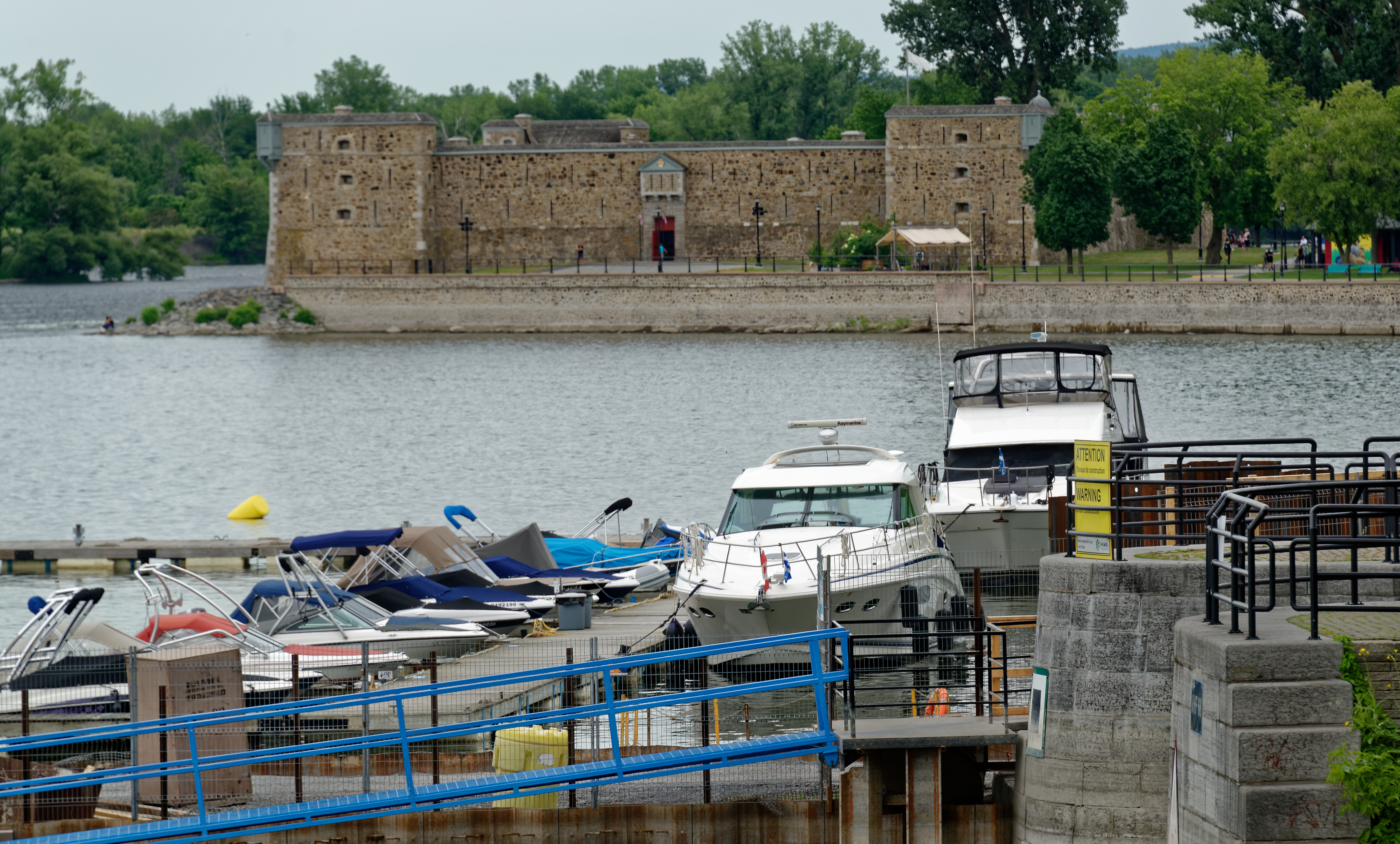
Chambly is a nice town. The old part of town along the river has been well-maintained and is an active and pretty spot. There are guided tours of the fort. A park is nearby with a bandstand and frequent events. Casual restaurants and a microbrewery are within walking distance. Two grocery stores are within five-minute walk of the marina.
July 22: The Chambly Canal
We left Chambly, Quebec, on Tuesday and headed to St. Jean sur Richelieu. Per Google Maps, if we had been in a car, it would have taken 18 minutes. On Eggy it took us about 7.5 hours. Only 3.5 hours of that was actually travel time, the rest was waiting for locks or bridges, or time in the locks. For more information about this canal, go to https://www.pc.gc.ca/en/lhn-nhs/qc/chambly/activ/navigation.
I mentioned the Quebec construction holiday started on Saturday. A lot of those boaters from Quebec like to travel down the Chambly Canal to Lake Champlain. So there was a bit of a line.
The canal consists of nine locks and seven swing bridges that allow boats to be raised (or lowered) 80 feet. It runs partly through the Richelieu River and partly through a dug canal (to avoid rapids on the river). The locks are smaller than what we have seen before and only hold four to six boats. The manual locks are operated by Parks Canada. When we went to bed Monday, we could see that the blue line (waiting area) had six boats, all it could fit. We headed over to the line as soon as the first group went through at 9:30 but did not get into the first lock until 11:30.

First Chambly lock
Frequently, you can see the rapids and falls in the river while on the canal. It makes you marvel at how the first settlers traveled through the area. In one of the locks, we saw a mink family. The lock tender told me that they had been worried because they had not seen the baby for a few days, but he came to visit us.
Because we were going up, which is always a bit rougher, and the strength of the water coming into the locks, Wes and I were both working hard during the lockings. The water flow wanted to push Eggy into the boats behind us or the lock wall, and we had to keep her from doing either – in 90-degree temperatures. We were glad when we docked at a marina in St. Jean.
July 22-24, 2019: St. Jean sur Richelieu
On Tuesday night after our long trip through the Chambly canal, we docked in St. Jean sur Richelieu, a nice community near the start of Lake Champlain. (https://lenautique.com/)
At the end of the canal is an old lift bridge. When we came through on Tuesday, there was an opening delay. The staff was on the radio in French with the boat behind us, but we could not understand what the issue was, and eventually it was raised. We noticed that a new bridge was being built to replace the old one.
On Wednesday, Wes noticed that they had moved a crane to the location (which we could just make out from the back of our boat). He could see that they were raising and lowering the old bridge using the crane. We were glad we made it through the day before.
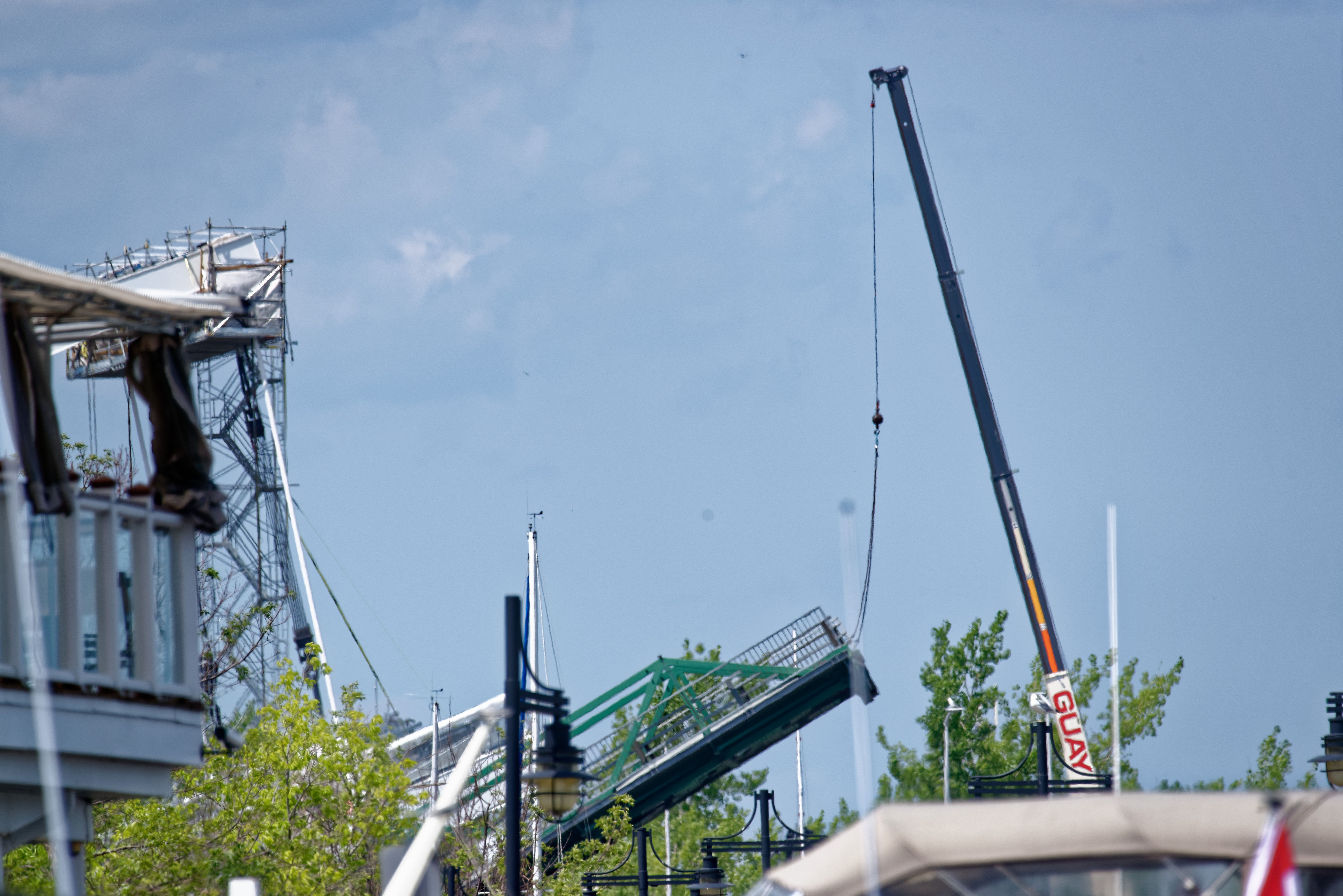
July 26-28, 2019: The Richelieu to Lake Champlain
When we left St. Jean, we cruised 22 miles on the Richelieu River. There was much less traffic and we had a nice ride. We cruised slowly, allowing us to enjoy the sights.
We cruised by Fort Lennox, built between 1819 and 1829, after the War of 1812. It was designed to keep us pesky Americans from attacking again. Previously, there had been a French fort at this location. The fort normally opens with tours and staff. However, several years ago, it was determined that the foundations were crumbling and it was closed for renovations.
We then crossed the international border and were back in the US. A large bridge crosses the border. Just as we were about to go under it, Wes noticed that there were lights flashing and a horn blaring on the shore and that there was a customs trailer set up. It turns out that we needed to stop in and report returning to the US in person.
This is a totally different procedure than we use (as of 2019) to report in when we cross into the US on Lake Ontario. We typically use a phone application called “ROAM” immediately after we dock or anchor in US waters. The documentation we had indicated that was the process for all ports of entry between the US and Canada. Fortunately, we stopped and our paperwork was in order so we were soon back under way.
Farther down the river, we passed Fort Montgomery, which was intended to protect the US from the British (in Canada) when it was started in 1816. The fort was abandoned in 1870 and was eventually privately purchased. The fort and island are for sale (as of 2019). The sign says the price is $2.9 million but we understand they are willing to sell for under $1 million.
We docked and enjoyed a nice evening in Rouses Point, within sight of Lake Champlain. (https://shmarinas.com/locations/safe-harbor-gaines/) As a special welcome back to the US, we ordered pizza delivery!
On Saturday, we traveled on Lake Champlain to Plattsburgh, NY. We beat the rain and enjoyed a full rainbow in the evening. https://plattsburghboatbasin.com/ )
July 29-Aug. 2, 2019: Burlington, Vt.
On Monday, July 29, we headed from Plattsburgh, NY to Burlington, Vt. The trip on Lake Champlain was beautiful. The water was flat with little traffic. We cruised slowly so we could enjoy the sights. It was the perfect day for a boat ride. You can see both the Adirondack and Green mountains. The water is deep blue. It is a large lake, and can kick up strong storms, however it has been fairly calm when we have been cruising it. (https://enjoyburlington.com/place/community-boathouse-marina/ )

Lake Champlain
Wes and I enjoy towns and cities that have walkable areas with restaurants, activities and stores close to the water. Burlington has all of those and is also rich in nearby historical sites. (In case you have not figured it out yet, we like historical places.)
We rented a “land dingy” for a few days so we could explore some of the areas where it would be hard to dock Eggy. Those included Crown Point and Fort Ticonderoga. We spent most of one day at Fort Ticonderoga. They had a special session that allowed us to handle some of the exhibit pieces.
Burlington is full of life. It has a street market that is open every day all year. There are lots of stores and restaurants. Friday was the start of its 12th annual “Festival of Fools” weekend with all kinds of street performers, in addition to the musicians that are normally playing on the street. We particularly enjoyed a couple of the acrobatic acts.
Thanks to a young friend who attended school in Vermont, we had a list of recommended restaurants. There were so many to choose from that we could have floundered around and missed the best but she pointed us to some great places. We normally eat about half our dinners on board but we went to four great places all within an easy walk of the boat.

Aug. 3-Aug. 5: Lake Champlain and Burlington to Whitehall, NY
From Burlington, Vt., to Whitehall, NY, we had another marvelous trip on Lake Champlain. The lake is amazing. The northern portion above Crown Point, NY, is 71 miles long, and in some places nine miles wide and 200 feet deep. It is more like a river once you get south of Crown Point.
We broke the trip into two steps since the river portion is narrow and windy and we did have 90+ miles to cover. We stayed at a nice marina in Port Henry, NY, and then moved on to Whitehall, NY, where we stayed Sunday and Monday.
Both marinas are small and have been recently taken over by new owners who are trying to make a go of a tough business. In Port Henry, there is a leprechaun overlooking the marina which I thought was adorable. (https://www.porthenrymarina.com/)
Whitehall has a tavern as part of the marina property. Officially it is closed on Sundays and Mondays. When we docked, the owner said, “We have enough local folks around today we will open and cook dinner for folks. Come up if you want.” (http://www.newwhitehallmarina.com /) We did and it was nice.
Whitehall is considered the birthplace of the US Navy. There were many naval battles in the area during the Revolutionary War. The ships for those battles were largely built or retrofitted in Whitehall. The US Navy also produced the ships used in the War of 1812 in Whitehall. A museum is in a 1917 canal terminal building. The museum includes artifacts, photographs and a diorama depicting the shipyard where the first US naval fleet was built in 1776.
Outside the museum, the remains of the US Ticonderoga are displayed under an open roof. The ship was built in Vergennes, Vt., a town we drove through on Lake Champlain.
Whitehall is at the southern end of Lake Champlain and is the site of the first lock (when headed south) of the Champlain Canal. All the canals we will travel for the remainder of our trip, including the Champlain Canal, are part of the New York State Canal System. A great resource for information on these canals is http://www.nycanals.com/Main_Page.
Aug. 6 -9, 2019: The Champlain Canal
After leaving Whitehall on Tuesday morning, we traveled through the Champlain Canal. The canal connects the Hudson River to Lake Champlain. In the late 1700s, the common route from New York City to Canada was up the Hudson to a town called Fort Edward, then by land to Lake George and then back on water at Lake Champlain.
Completed in 1822 from Waterford (on the Hudson) to Whitehall (on Lake Champlain), the canal provided an all-water route. The canal has been improved since then, reaching its final configuration in 1918 as part of the New York State Barge Canal system.
A hand-dug canal goes 23 miles from Whitehall to Fort Edward. The canal then follows the Hudson River to Waterford for about 37 miles. There are 11 locks on the canal (the final one is numbered 12, but they skipped No. 10).
We traveled from Whitehall to Fort Edward, going through five locks and under 12 bridges on a beautiful day. We docked in Fort Edward just as the typical late summer thunderstorms arrived. The forecast for Wednesday called for storms most of the day so we decided to spend two nights on the town wall. The town has set up a nice park area and provides free electricity and water to boaters. It was a pretty and quiet spot. Five or six other boats tied off there by early evening.
Of course it did not storm on Wednesday. Every hour, forecasters moved back the projected start of thunderstorms. We had a relaxing, if a bit frustrating, day. Lots of boat chores were accomplished.
Since we had spent an extra day, we decided to skip our next planned stop and travel to Waterford on Thursday. The day started out calm and beautiful. As we passed Mechanicville, NY, our original planned stop, we were pleased that the rain was staying away. However, shortly after that the skies darkened.
It started to rain as we entered each of the last three locks. As we came out, the sky would lighten up until we got to the next lock. Locking in the rain can be unpleasant for boaters and lock staff. It was still fun, and we are glad we pushed on.
When we first went through the locks, other boats made me nervous so I liked it when I was “Queen of the Locks.” I am over the nerves, but it was still fun that we were alone in all 11 locks.
When you arrive at Waterford from the north (as we did), you can continue on the Hudson and go into New York City, or turn west and be at the first set of locks for the Erie Canal. While heading down the Hudson would be fun, we both knew it was time to come home. So we turned west.
Waterford Junction
Waterford has a nice town dock that is busy with canal traffic. We arrived in time to get a nice spot for our two nights. http://www.town.waterford.ny.us/harbor-visitors-center.html
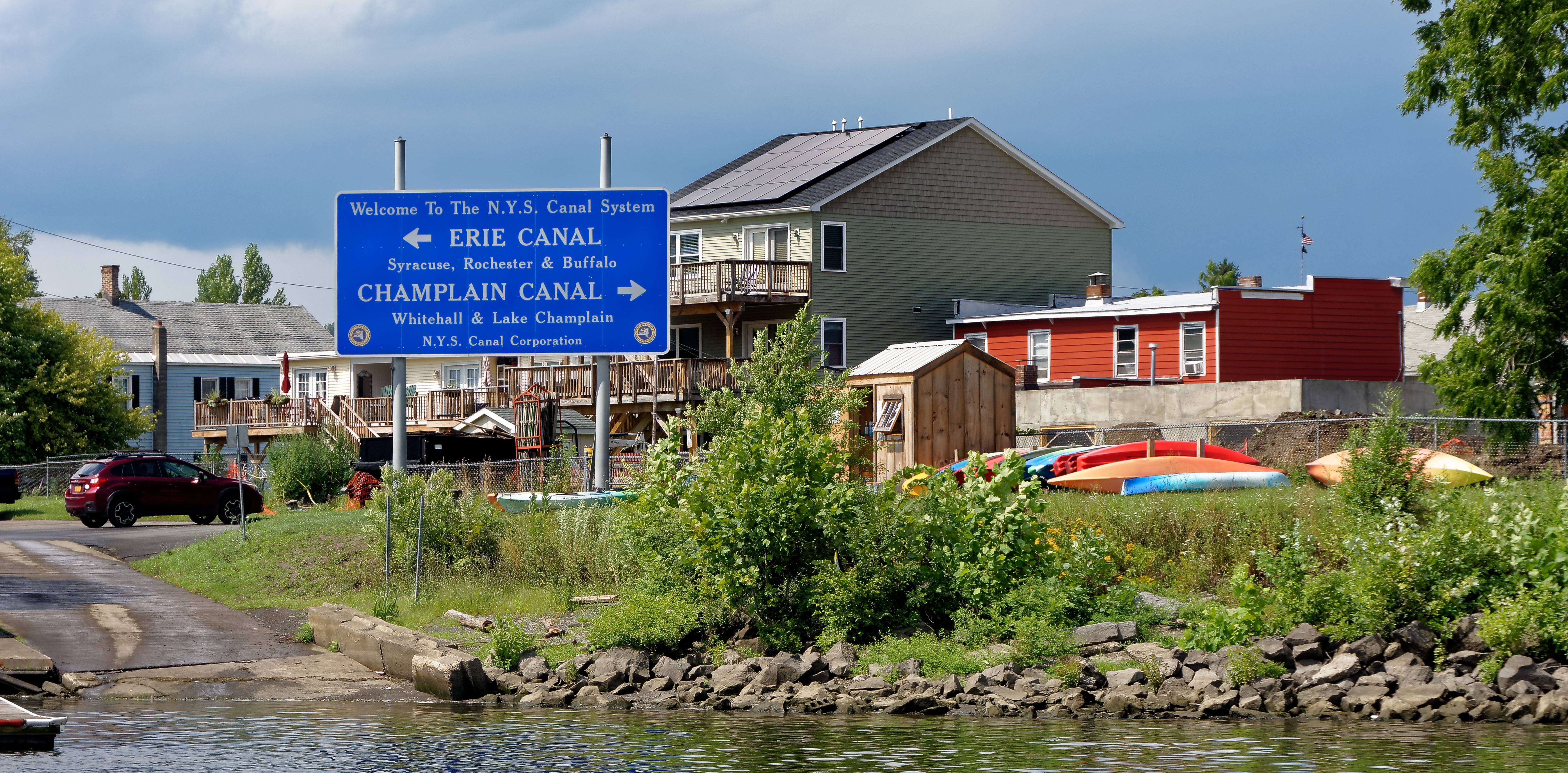
Aug. 10-11, 2019: Erie Canal to Schenectady
We left Waterford on Saturday and started west on the Erie Canal. We traveled the western part of the canal in 2017 but have not been on this section before. The canal connects the Hudson River and the Champlain Canal to Lake Erie. We will turn north to Oswego part way to get to Lake Ontario.
At Waterford, we went through five locks in less than two miles. In total, the locks raised us more than 120 feet. We were the only ones in the locks and went quickly. The dams at each of the locks were very impressive.
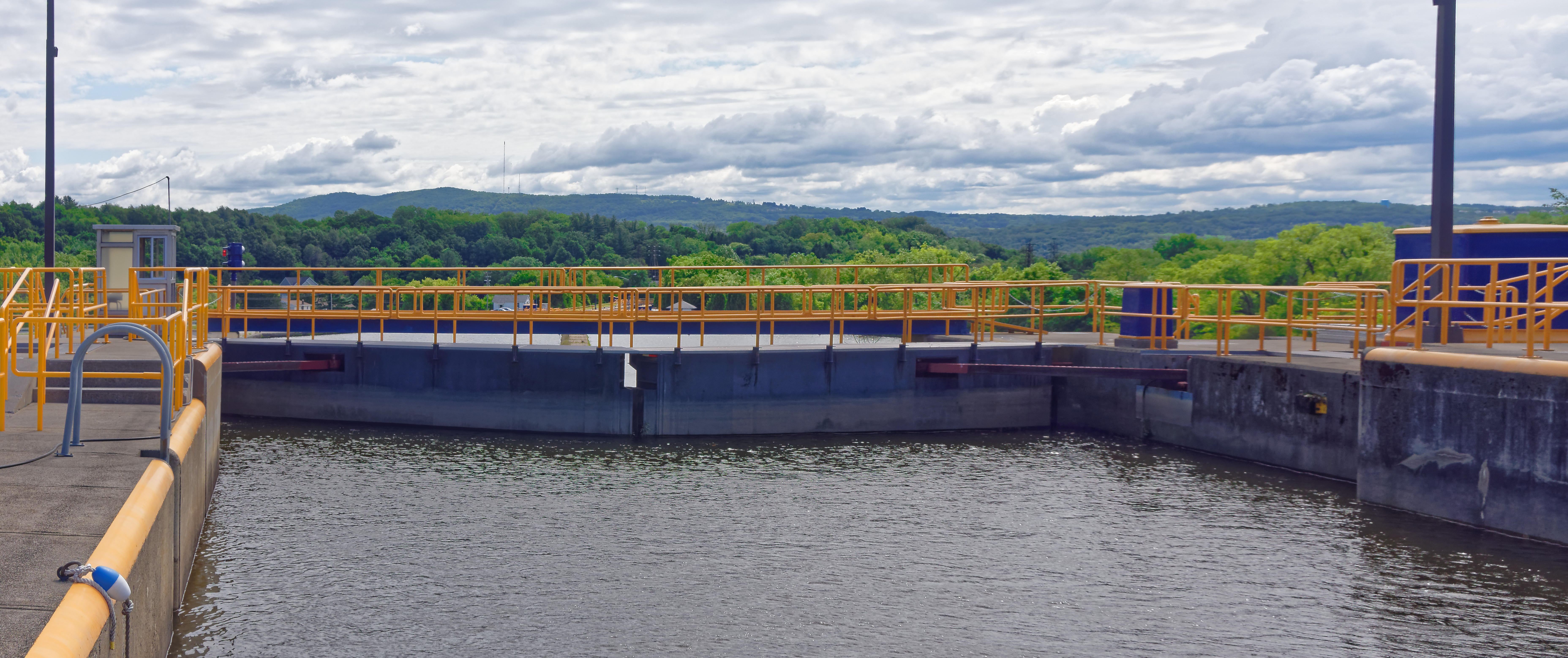
Climbing out of the Hudson
We then went about 20 miles and through another lock to arrive in Schenectady, NY. We spent two nights at a recently built marina in a complex of new condos and apartments. A brew pub, a wine bar and a casino were next to the docks. The marina docks were the sturdiest we have ever seen and the harbor is one of the most protected. https://www.themohawkharbor.com. We have decided this will probably be our longest trip (time wise) as we were both ready for home despite still having a great time.
Aug. 12-14, 2019: Erie Canal to Canajoharie
We left Schenectady on Monday and traveled to Canajoharie, NY. While there we saw a way for those of you who do not own boats to travel the Erie Canal: a cruise liner recently started traveling up the Hudson and through the Erie Canal to Kingston and beyond. It holds 84 passengers and looks like a fun way to travel, if not as nice as Eggy.
A couple of days later, we were told that the ship ran aground, so maybe there are still a few bugs in the system.
During most of the 40-mile trip, we were on the Mohawk River. We went through five locks that raised us approximately 68 feet.
We traveled through the town of Fonda where Henry Fonda is from. During the trip, we saw several work barges and the remains of an aqueduct from the 1840s canal. Near Amsterdam, NY, there was also an 80-foot smokestack that has an old Volkswagen car sitting on top of it, not something you see every day! How did it get up there?
Canajoharie means “boiling pot” in the Mohawk language. Several miles out of town is a series of cascading waterfalls that form boiling or “kettle” pots. We did not visit there, but we did go to the local library which is also an art gallery.
Bartlett Arkell, who founded the Beechnut Food Co. in Canajoharie, was an art collector. He wanted to share the art he saw when he traveled to Europe in the 1920s. He paid to have copies made of works like Rembrandt’s Night Watch and donated them to the library for display. The Beechnut plant in Canajoharie has closed but the work moved to the nearby town of Amsterdam, NY.
One of the fun things about traveling through the small towns is the people we meet. As we were preparing to leave, the Canajoharie police chief stopped by the park where we were docked to make sure we had a good stay, and to check out the boat. We had a nice visit.
Aug. 15-16, 2019: Little Falls
On Wednesday, we traveled to Little Falls, NY. We passed the house of a revolutionary war general, Nickolas Herkimer. It is well preserved and open as a museum. They even have a dock we could have used to tie off for a visit. However, we decided to pass.
Just outside of Little Falls, we passed through the tallest lock on the Erie Canal, Lock 17. It took us up 40 feet. It has a door on the east side that is unique in that it is raised up out of the water to let boats in and out rather than opening into the lock. There is only one other like that in North America, and we went through that in 2016: the Carillon Lock on the Ottawa River.
Inside Lock 17
According to Skipper Bob, one of the books we used to plan our trip, many people consider Little Falls one of the best stops on eastern Erie and we can see why. The Rotary Club manages the harbor. The facilities and nearby park are nice. The town is about a mile away but people offer you a ride from the marina. There is also a taxi service.
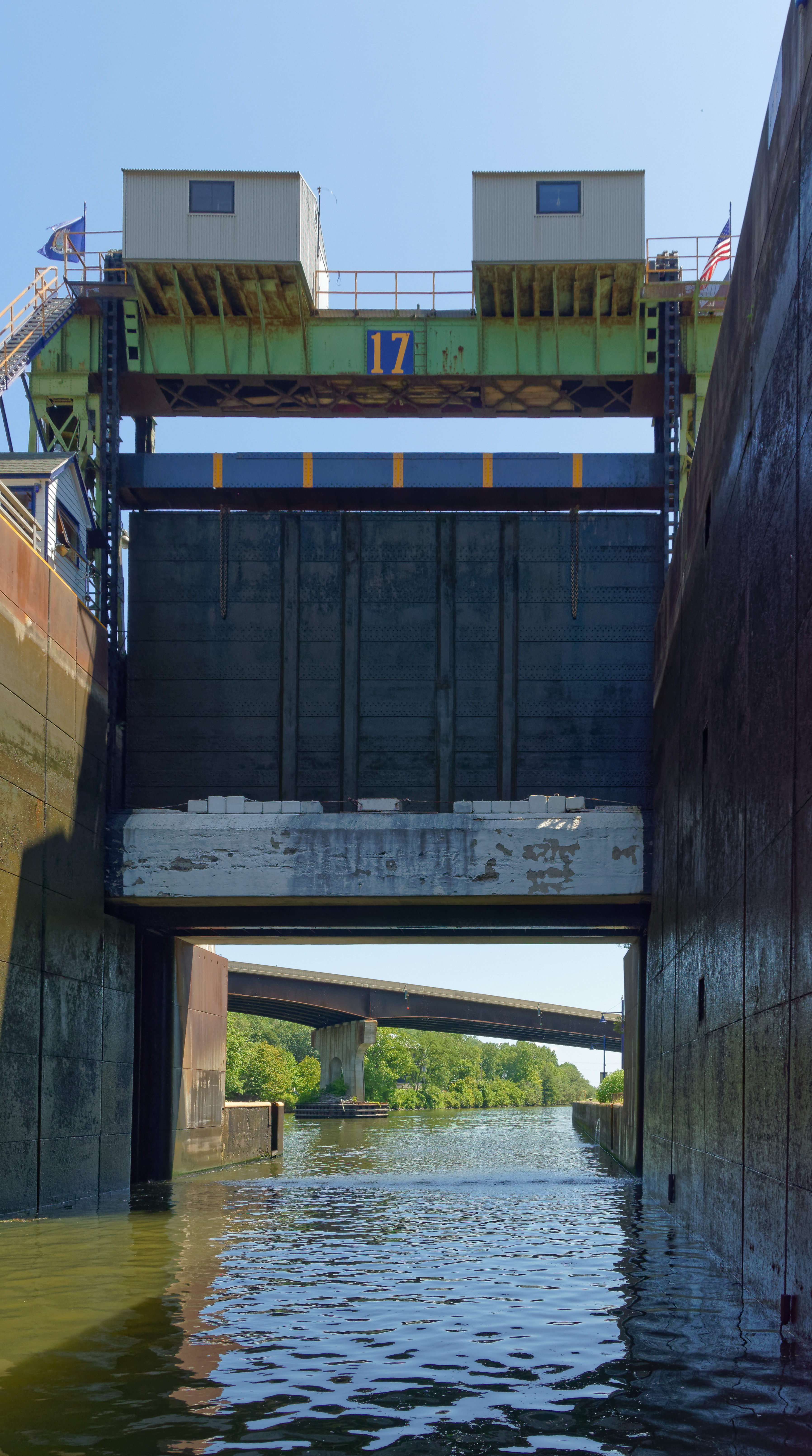
Little Falls Town Dock
There seemed to be more activity in the city than in some of the old canal towns we have been visiting. There were several restaurants, and it was busy for a Wednesday night with a nice mix of local folks.
Before dinner Thursday on Eggy, we walked around the weekly “cruise in the park” where about 10 classic cars came out for an evening of music and hot dogs. The locals let us know that the impending rain reduced the number of cars significantly. Some weeks they get as many as 50.
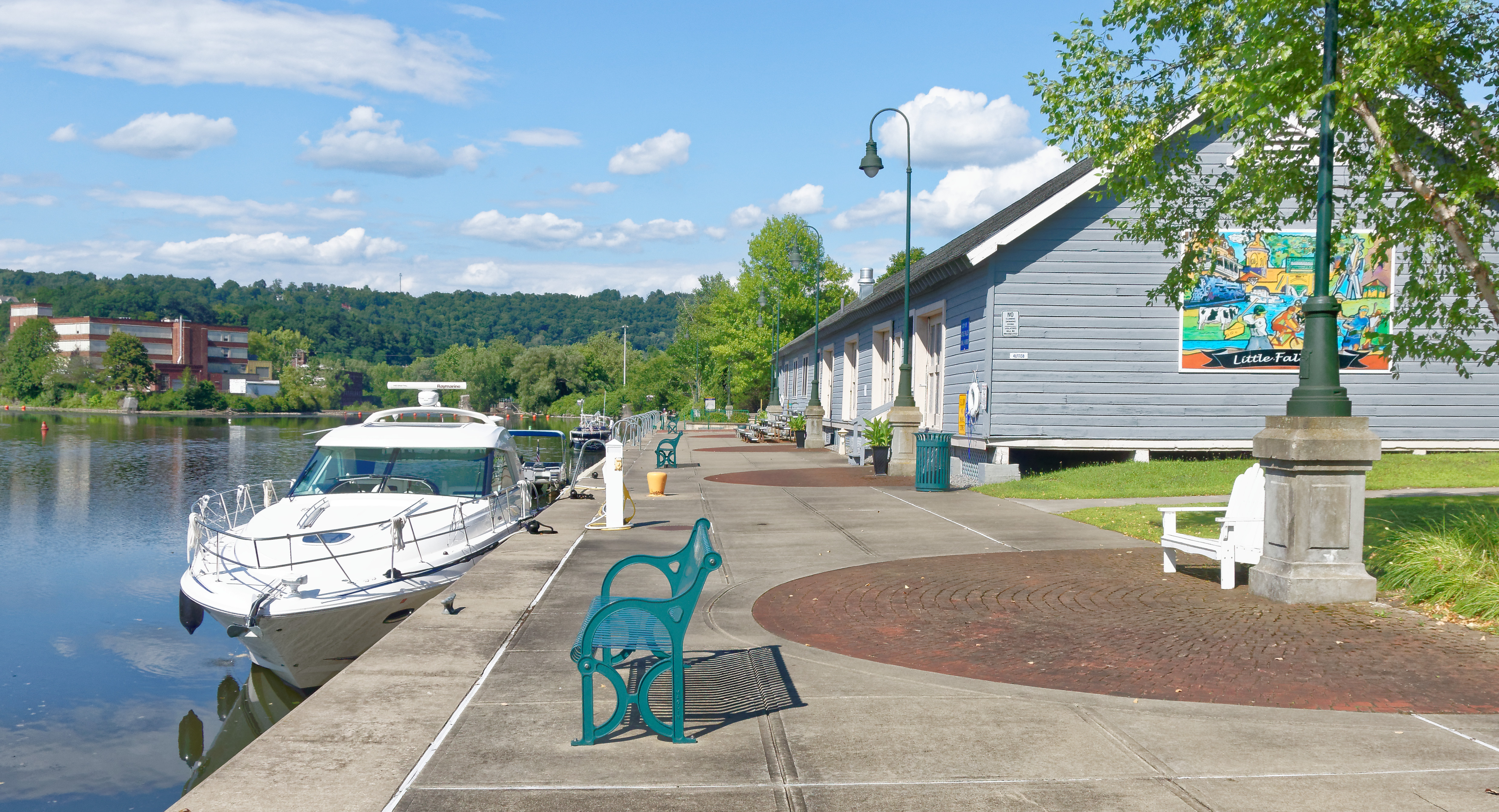
Aug. 16, 2019: Utica
On our way to Utica, we went through a Guard Gate, one of many on the canal. These are located on the canal to prevent downstream flooding. The gate can be brought down to protect the area if a dam or lock breaks.

We saw several areas where the canal was being dredged to make sure it maintains the advertised depth of 12 feet. That is good since we also went through some areas where it was less than 6 feet. Hopefully, those will get dredged soon.
The Utica town wall is managed by the Italian restaurant on site. The restaurant was a family-owned place with great food. It was nice that the restaurant was close to the boat because we had a heavy thunderstorm just as we were headed back to the boat.
Aug. 17-20, 2019: Sylvan Beach and Brewerton
On Saturday, we headed to Sylvan Beach at the entrance to Oneida Lake, the largest lake on the canal. We had left Utica early because there were predictions of heavy storms (again) in the late afternoon. We needed to get pumped out (you boaters would understand) so it took us a while to get settled at the dock. I was watching the heavy clouds approach and was a bit concerned.
We had just tied off when the boater behind us started adding additional lines to his boat. When I looked his way, he said, “Oh haven’t you seen the tornado alert?” Wes quickly added some safety lines.
We became more concerned when we realized that we were docked next to an RV park. We recalled all the times we have seen pictures of flying RVs during tornados. The weather radio kept saying that it could hit within less than 10 minutes and that there could be heavy wind damage. All we had was a heavy thunderstorm, but no tornado, and no flying RVs.
On Sunday we left Sylvan Beach and quickly crossed Onedia Lake to Brewerton, as more storms were predicted. However, they passed to the south of us and we had an uneventful cruise.
Eggy has been performing excellently the entire cruise, and there is nothing like “pod drives” which allow you to go sideways, when you are doing locks. However, a few weeks ago, Wes noted a small leak of the steering drive fluid. We have had work done on the drives before at the Brewerton Boat Yard and been very satisfied. So, since we were going by anyway, Wes had contacted them, made an appointment and had them order all the parts he thought they would need.
They completed the work in a few hours Monday morning, but those pesky summer storms were kicking up, so we waited until Tuesday to leave.
Aug. 20, 2019: Oswego Canal and Home
We woke Tuesday to a nice cool day and a pretty blue sky in Brewerton. We took off a bit early and traveled through the one lock remaining to the 3 Rivers area of the Erie Canal. It is called 3 Rivers because it is where the Oswego, the Seneca and the Oneida rivers come together.
We then turned north and made great time through the seven locks of the Oswego Canal. We were lowered in each lock since the river flows into Lake Ontario. By the time we reached the lake, we were 118 feet lower than at the start of the day.
We had planned to stop for the night in Oswego and then head home. But it was only 2:30 and the lake was calm, so we pressed on and returned home. We pulled into our home dock at 5:30, tired and happy and a little sad that the great adventure was completed. We made memories we will enjoy for years.

Home: Irondequoit Bay
If you are interested in traveling in any of these areas and would like more information, feel free to reach out to me at mcmicket@gmail.com. We love to share our stories. Thank you for “traveling” along with us.

